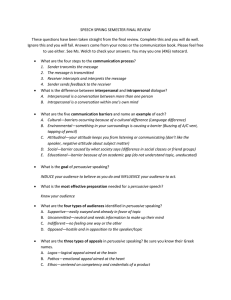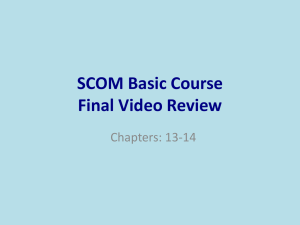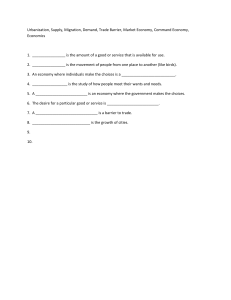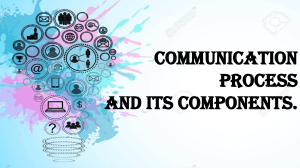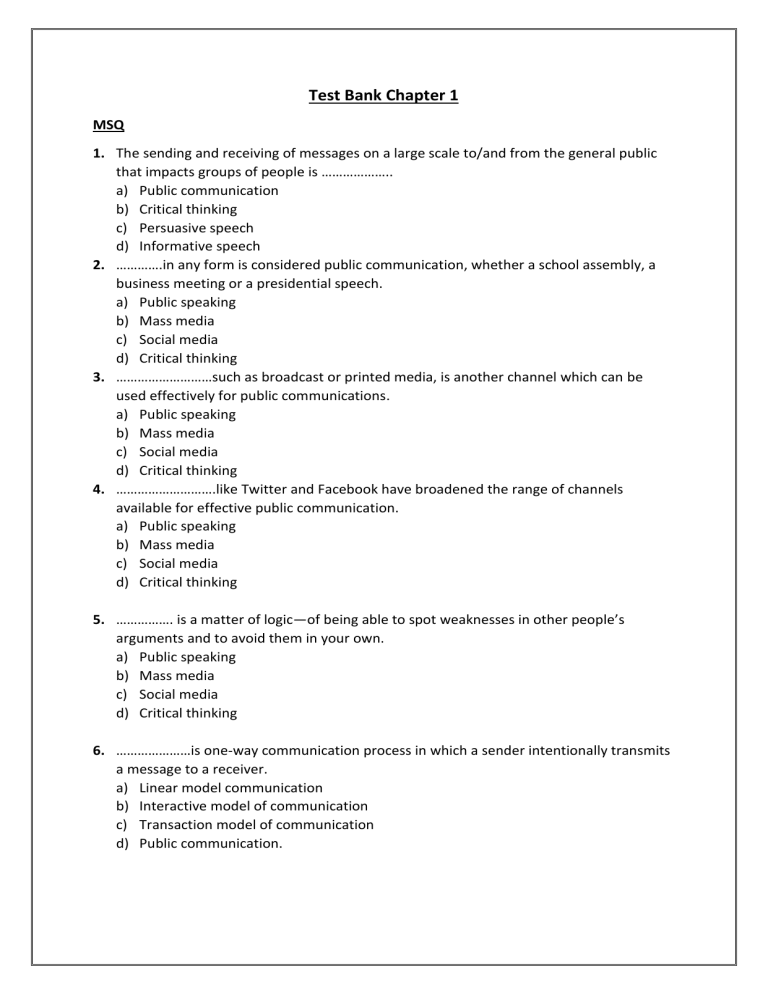
Test Bank Chapter 1 MSQ 1. The sending and receiving of messages on a large scale to/and from the general public that impacts groups of people is ……………….. a) Public communication b) Critical thinking c) Persuasive speech d) Informative speech 2. ………….in any form is considered public communication, whether a school assembly, a business meeting or a presidential speech. a) Public speaking b) Mass media c) Social media d) Critical thinking 3. ………………………such as broadcast or printed media, is another channel which can be used effectively for public communications. a) Public speaking b) Mass media c) Social media d) Critical thinking 4. ……………………….like Twitter and Facebook have broadened the range of channels available for effective public communication. a) Public speaking b) Mass media c) Social media d) Critical thinking 5. ……………. is a matter of logic—of being able to spot weaknesses in other people’s arguments and to avoid them in your own. a) Public speaking b) Mass media c) Social media d) Critical thinking 6. …………………is one-way communication process in which a sender intentionally transmits a message to a receiver. a) Linear model communication b) Interactive model of communication c) Transaction model of communication d) Public communication. 7. ………………………describes communication as a process in which participants alternate positions as sender and receiver and generate meaning by sending messages and receiving feedback within physical and psychological contexts. a) Linear model communication b) Interactive model of communication c) Transaction model of communication d) Critical thinking 8. ……………is the process of taking an idea or mental image, which is linked with words, and then speaking those words to convey a message. a) encoding b) decoding c) feedback d) linear model communication 9. ……………….. makes communication more interactive, two-way process, includes messages sent in response to other messages. a) encoding b) decoding c) feedback d) linear model communication 10. In ………………..a speaker communicates knowledge about a specific topic to an audience, to increase listeners’ understanding, awareness, by defining, describing, or explaining. a) Informative speech b) Persuasive speech c) Special occasion d) Transaction model communication 11. In ………………speaker attempts to persuade the audience to: Adopt his position in relation to a topic, Change attitudes, beliefs, behaviours, feelings, or values. a) Informative speech b) Persuasive speech c) Special occasion d) Transaction model communication 12. Speaking to entertain, engage, interest, charm listeners, and may include information about occasion is ………. a) Informative speech b) Persuasive speech c) Special occasion d) Transaction model communication 14. ………………….are related with the limitations of the human body and the human mind (memory, attention, and perception), they may result from individuals’ personal discomfort, caused by ill-health, poor eye sight, or hearing difficulties. a) Social barriers. b) Cultural barriers. c) Semantic Barrier d) Physiological barriers 13. If someone has personal problems such as worries and stress about a chronic illness, it may affect his/her communication with others, it is considered……… a) Social barriers. b) Cultural barriers. c) Semantic Barrier d) Psychological barriers 15. ………..are such as age, gender, socioeconomic status, and marital status may act as a barrier to communication in certain situations. a) Social barriers. b) Cultural barriers. c) Semantic Barrier d) Psychological barriers 16. ……….is poorly explained or misunderstood messages can also result in confusion. a) Social barriers. b) Cultural barriers. c) linguistic Barrier d) Psychological barriers True & False 1. These messages must be clearly and accurately sent and received with a high degree of understanding. ( ) 2. Feedback is the process of taking an idea or mental image, which is linked with words, and then speaking those words to convey a message. ( ) 3. Decoding is the reverse process of listening to words, thinking about them, and turning those words into mental images. ( ) 4. Encoding makes communication more interactive, two-way process, includes messages sent in response to other messages. ( ) 5. Change attitudes, beliefs, behaviors, feelings, or values informative speech. ( ) 6. They include anything that prevents or disables communicators to deliver the right message to the right person at the right time, or a receiver to get the right message at the right time. Public communication. ( ) 7. Halo effect: we form general opinions about certain groups, and then apply these opinions to every person in that group. ( ) 8. Stereotyping: we dislike someone because they have a quality we don’t value. ( ) 9. Past experience: if someone has good experiences in the past related to some particular situation, then he/she will try to avoid communication in that situation. 10. fair Comparison: we should evaluate each employee by how well be or she matches up to the standards for the Job. ( ) 11. pitchfork effect: we favor someone due to his attractiveness or charisma. ( ) 12. Appropriate Channel: Variation of channels helps the receiver understand the nature and importance of a message. ( ) 13. Unclear Messages: meaning, grammar, and words may act as a barrier to communication because the receiver may not be able to intercept the actual meaning of the message. ( ) 14. Be aware of language, message and tone. Consistency of Message one of communication barriers. ( ) 15. Follow up Communication: you shouldn’t try to know the weaknesses of the communication structure. ( ) Essay 1. List the speech communication process with drawing 2. Communication has many model, please compare between communication model and draw for illustrate? 3. Public speeches have different types please dicuss. 4. List Similarities Between Public Speaking and Conversation 5. There are many communication barriers, list them and select 4 types to explain. 6. How to Overcoming the communication barriers?
